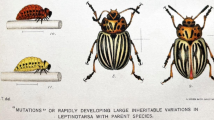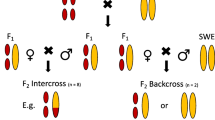According to reinforcement theory, sexual isolation between species in sympatry is strengthened by natural selection against maladaptive hybrids. Drosophila pseudoobscura and D. persimilis from four locations where these species are sympatric, and from three locations where only D. pseudoobscura has been found, were utilized in studies of sexual isolation. Multiple-choice observation chambers were used to record matings between sympatric and allopatric strains of the two species. There was a wide variation in sexual isolation between the two species in the four localities we studied. The average isolation index for sympatric strains of the species was not significantly different from the average index for allopatric strains. There were no meaningful differences between the isolation indices in sympatric and allopatric strains of the species. The failure to find a relationship is likely the result of gene flow among populations within the two species.
Similar content being viewed by others
References
W. W. Anderson J. Arnold D. B. Baldwin A. T. Beckenbach C. J. Brown S. H. Bryant J. D. Coyne L. G. Harshman W. B. Heed D. E. Jeffrey L. B. Klaczko B. C. Moore J. M. Porter J. R. Powell T. Prout S. W. Schaeffer J. C. Stephens C. E. Taylor M. E. Turner G. O. Williams J. A. Moore (1991) ArticleTitleFour decades of inversion polymorphism in Drosophila pseudoobscura Proc. Natl. Acad. Sci. USA 88 10367–10371
W. W. Anderson F. J. Ayala R. E. Michod (1977) ArticleTitleChromosomal and allozymic diagnosis of three species of Drosophila: D. pseudoobscura, D. persimilis, and D. miranda J.␣Hered. 68 71–74
W. W. Anderson C. J. Brown (1984) ArticleTitleA test for rare male mating advantage with Drosophila pseudoobscura karyotypes Genetics 107 577–699
W. W. Anderson L. Ehrman (1969) ArticleTitleMating choice in crosses between geographic populations of Drosophila pseudoobscura Am. Midl. Nat. 81 47–53
Carson, H. L. (1971). The ecology of Drosophila breeding sites. Harold L. Lyon Arboretum Lecture No. 2, Univ. of Hawaii, Honolulu, Hawaii
P. Casares M. C. Carracedo B. Rio R. Pineiro L. Garcia-Florez A. R. Barros (1998) ArticleTitleDisentangling the effects of mating propensity and mating choice in Drosophila Evolution 52 126–133
J. A. Coyne H. A. Orr (1997) ArticleTitle“Patterns of speciation in Drosophila” revisited Evolution 51 295–303
J. A. Coyne H. A. Orr (2004) Speciation Sinauer Associates Sunderland, Massachusetts
J. A. Coyne S. Y. Kim A. S. Chang D. Lachaise S. Elwyn (2002) ArticleTitleSexual isolation between two sibling species with overlapping races: Drosophila santomea and Drosophila yakuba Evolution 56 2424–2434
Dixon Schully, S., and Noor, M. A. F. (2004). Evaluating the mode of reinforcement in Drosophila pseudoobscura: Discrimination enhancement vs. preference evolution. Dros. Inf. Serv. (in press)
Th. Dobzhansky (1937) Genetics and the Origin of Species Columbia University Press New York
Th. Dobzhansky (1940) ArticleTitleSpeciation as a stage in genetic divergence Am. Nat. 74 312–321
Th. Dobzhansky (1944) ArticleTitleChromosomal races in Drosophila pseudoobscura and D. persimilis Carnegie Institution of Washington Publ. 554 47–144
Th. Dobzhansky (1945) ArticleTitleGenetic structure of natural populations Carnegie Institution of Washington Year Book 44 127–134
Th. Dobzhansky (1974) ArticleTitleActive dispersal and passive transport in Drosophila Evolution 27 565–575
Th. Dobzhansky P. C. Koller (1938) ArticleTitleAn experimental study of sexual isolation in Drosophila Biologischen Zentralblatt 58 589–607
Th. Dobzhansky O. Pavlovsky (1971) ArticleTitleExperimentally created incipient species of Drosophila Nature 230 289–292
Th. Dobzhansky J. R. Powell (1975) Drosophila pseudoobscura and its American relatives R. C. King (Eds) Handbook of Genetics NumberInSeriesVol. 3. New York Plenum 537–587
Th. Dobzhansky S. Wright (1947) ArticleTitleGenetics of natural populations XV. Rate of diffusion of a mutant gene through a population of Drosophila pseudoobscura Genetics 32 303–324
L. Ehrman (1965) ArticleTitleDirect observations of sexual isolation between allopatric and sympatric strains of different Drosophila paulistorum races Evolution 19 459–464
L. Ehrman (1966) ArticleTitleMating success and genotype frequency in Drosophila Anim. Behav. 14 332–339
L. Ehrman (1970) ArticleTitleThe mating advantage of rare males in Drosophila Proc. Natl. Acad. Sci. USA. 65 345–348
L. Ehrman (1971) ArticleTitleNatural selection for the origin of reproductive isolation Am. Nat. 105 479–483
L. Ehrman (1983) ArticleTitleFourth report on natural selection for the origin of reproductive isolation Am. Nat. 121 290–293
A. A. Elens J. M. Wattiaux (1964) ArticleTitleDirect observation of sexual isolation Dros. Inf. Serv. 39 118–119
J. Hey R. Nielsen (2004) ArticleTitleMultilocus methods for estimating population sizes, migration rates and divergence times, with applications to the divergence of Drosophila pseudoobscura and D. persimilis Genetics 167 747–760
D. J. Howard (1999) ArticleTitleConspecific sperm and pollen precedence and speciation Annu. Rev. Ecol. Syst. 30 109–132
A. S. Hunter (1960) ArticleTitleDrosophilidae of Bogota, Colombia Dros. Inf. Serv. 34 86
J. S. Jones S. H. Bryant R. C. Lewontin J. A. Moore T. Prout (1981) ArticleTitleGene flow and the geographical distribution of a molecular polymorphism in Drosophila pseudoobscura Genetics 98 157–178
K. Y. Kaneshiro (1976) ArticleTitleEthological isolation and phylogeny in the planitibia subgroup of Hawaiian Drosophila Evolution 30 740–745
S. Kessler (1966) ArticleTitleSelection for and against ethological isolation between Drosophila pseudoobscura and Drosophila persimilis Evolution 20 634–645
Y. -K. Kim H. R. Koepfer L. Ehrman (1996) ArticleTitleDevelopmental isolation and subsequent adult behavior of Drosophila paulistorum. III Alternative rearing. Behav. Genet. 26 27–37
P. Knoppien (1985) ArticleTitleRare-male mating advantage: a review Biol. Rev. 60 81–117
K. F. Koopman (1950) ArticleTitleNatural selection for reproductive isolation between Drosophila pseudoobscura and Drosophila persimilis Evolution 4 135–148
C. A. Machado R. M. Kliman J. A. Markert J. Hey (2002) ArticleTitleInferring the history of speciation from multilocus DNA sequence data: the case of Drosophila pseudoobscura and close relatives Mol. Biol. Evol., 19 472–488
Ch. Malogolowkin-Cohen A. S. Simmons H. Levene (1965) ArticleTitleA study of sexual isolation between certain strains of Drosophila paulistorum Evolution 19 95–103
J. L. Marshall M. L. Arnold D. J. Howard (2002) ArticleTitleReinforcement: The road not taken Trends Ecol. Evol. 17 558–563
H. J. Muller (1942) ArticleTitleIsolating mechanisms, evolution, and temperature Biol. Symposia 6 71–125
M. A. Noor (1995) ArticleTitleSpeciation driven by natural selection in Drosophila Nature 375 674–675
M. A. Noor (1999) ArticleTitleReinforcement and other consequences of sympatry Heredity 83 503–508
M. A. Noor K. L. Grams A. Bertucci Y. Almendarez J. A. Reiland (2001) ArticleTitleThe genetics of reproductive isolation and the potential for gene exchange between Drosophila pseudoobscura and D. persimilis via backcross hybrid males Evolution 55 512–521
D. Ortiz-Barrientos B. A. Counterman M. A. F. Noor (2004) ArticleTitleThe genetics of speciation by reinforcement PLoS Biol. 2 1–8
S. W. Schaeffer E. L. Miller (1991) ArticleTitleNucleotide sequence analysis of Adh genes estimates the time of geographic isolation of the Bogota population of Drosophila pseudoobscura Proc. Natl. Acad. Sci. USA 88 6097–6101
S. W. Schaeffer E. L. Miller (1992) ArticleTitleEstimates of gene flow in Drosophila pseudoobscura determined from nucleotide sequence analysis of the alcohol dehydrogenase region Genetics 132 471–480
M. R. Servedio M. A. Noor (2003) ArticleTitleThe role of reinforcement in speciation: theory and data Ann. Rev. Ecol. Syst. 34 339–364
R. W. Siegel J. C. Hall D. A. Gailey C. P. Kyriacou (1984) ArticleTitleGenetic elements of courtship in Drosophila: mosaics and learning mutants Behav. Genet. 14 383–410
E. B. Spiess (1970) Mating propensity and its genetic basis in drosophila M. K. Hecht W. C. Steere (Eds) Essays in evolution and genetics in honor of Theodosius Dobzhansky Appleton Century Crofts New York 315–379
H. T. Spieth (1968) Evolutionary implications of sexual behavior in Drosophila Th. Dobzhansky M. K. Hecht W. C. Steere (Eds) Evolutionary biology NumberInSeriesVol. 2 Plenum New York 157–193
H. T. Spieth J. Ringo (1983) Mating behavior and sexual isolation in Drosophila M. Ashburner H. L. Carson J. M. Thompson SuffixJr. (Eds) The genetics and biology of Drosophila NumberInSeriesVol. 3c Academic Press New York 223–284
R. L. Wang J. Hey (1996) ArticleTitleThe speciation history of Drosophila pseudoobscura and close relatives: inferences from DNA sequence variation at the period locus Genetics 144 1113–1126
R. L. Wang J. Wakeley J. Hey (1997) ArticleTitleGene flow and natural selection in the origin of Drosophila pseudoobscura and close relatives Genetics 147 1091–1106
M. Wasserman H. R. Koepfer (1977) ArticleTitleCharacter displacement for sexual isolation between Drosophila mojavensis and Drosophila arizonensis Evolution 43 362–381
Author information
Authors and Affiliations
Corresponding author
Additional information
This paper is dedicated to Prof. Lee Ehrman – excellent scientist, friend, and mentor.
Rights and permissions
About this article
Cite this article
Anderson, W.W., Kim, YK. Sexual Isolation Between Sympatric and Allopatric Populations of Drosophila pseudoobscura and D. persimilis*. Behav Genet 35, 305–312 (2005). https://doi.org/10.1007/s10519-005-3222-3
Received:
Accepted:
Issue Date:
DOI: https://doi.org/10.1007/s10519-005-3222-3




